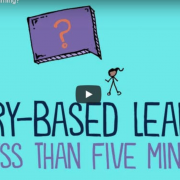How to Help Students Ask Great Questions in PBL
Student Inquiry in PBL
Student inquiry is at the heart of student choice. When students are able to ask their own questions, they can chase their curiosity and tap into their own interests. They can build on their prior knowledge and build a bridge to new information that they are analyzing. Student inquiry can help improve student motivation and buy-in, which, in turn, can help the learning to stick. This is one of the reasons teachers have incorporated inquiry-based learning into their classrooms. If you’re not familiar with this concept, please check out the following video:
While inquiry-based learning is not the same thing as project-based learning, there are some significant overlaps. You might do an inquiry-driven mini-project such as the Wonder Day project I emailed you a few months back:
 Download the Wonder Day Mini-Project Files
Download the Wonder Day Mini-Project Files
 Download the Wonder Week Mini-Project Files
Download the Wonder Week Mini-Project Files
If you’re doing a design thinking project, you’ll likely have students generate questions in the Ask Tons of Questions phase of the LAUNCH Cycle. In more standard PBL projects, students will generate frequent questions as they engage in on-going inquiry. This often begins toward the beginning of a PBL unit when students create a knows / needs to know chart or when they jot down their ideas on wonder wall (which always makes me think of Oasis). But this inquiry isn’t limited to the start of the project. Students engage in inquiry during research as they ask critical questions about the information they discover. This can lead to knew questions, new inquiries, and new information. During brainstorming, students ask questions about their ideas. As they plan their products and work on prototyping, they frequently ask questions like, “Is this feasible? Will this work? What do we do next?” Student-generated questions are at the heart of the assessment and reflection process as well.
In other words, students should be asking questions throughout the entire PBL process. However, this doesn’t always come naturally. So, we’re going to explore some strategies and scaffolds for helping students with the inquiry process.
A Gradual Release Approach
Sometimes students struggle with inquiry because they still need a little more direction from their teachers. Inquiry doesn’t necessarily mean students are on their own asking whatever question they’re curious about and finding the answers. Heather Banchi and Randy Bell conceptualize inquiry on a continuum from a more guided to open approach.
- Level 1: Confirmation Inquiry
The teacher has taught a particular science theme or topic. The teacher then develops questions and a procedure that guides students through an activity where the results are already known. This method is great to reinforce concepts taught and to introduce students into learning to follow procedures, collect and record data correctly and to confirm and deepen understandings. - Level 2: Structured Inquiry
The teacher provides the initial question and an outline of the procedure. Students are to formulate explanations of their findings through evaluating and analyzing the data that they collect. - Level 3: Guided Inquiry
The teacher provides only the research question for the students. The students are responsible for designing and following their own procedures to test that question and then communicate their results and findings. - Level 4: Open/True Inquiry
Students formulate their own research question(s), design and follow through with a developed procedure, and communicate their findings and results. This type of inquiry is often seen in science fair contexts where students drive their own investigative questions.
So, the first big idea is that we can scaffold student inquiry by deciding which inquiry level we want to use for various phases of PBL. Other times, though, the issue is one of language. Which leads to my next thought . . .
Language Supports for Student Questions
Sometimes students struggle with inquiry because they lack the language to ask key questions. They are curious but they haven’t figured out how to craft research questions, ask clarifying questions, or ask their own self-reflection questions. In some cases, it might be that an ELL students knows how to ask questions in their own language but they need some scaffolds to help craft questions in English. In other cases, it might be that students haven’t seen certain types of questions modeled for them. They might be curious but they need to see some examples of questions that will then inspire them to ask their own inquiry questions.
As teachers, we can model this process by sharing examples of questions and providing sentence frames for students to develop their own questions. We can integrate these moments in small ways. For example, during direct instruction you might have students submit questions anonymously that you can then answer. You might also create time and space for these questions during each phase of a project. Students can ask questions before research but you can also ask them to ask one another questions (general questions, follow-up questions, clarifying questions) about what new facts they are learning through their research.
The following is a set of sentence stems that you can use as a starting place. I’ve separated these questions into various categories for the types of questions students might ask.




Leave a Reply
Want to join the discussion?Feel free to contribute!